
Ryan Brenner (Colorado State University)
Mentor: Dr. Paulinus Chigbu
Research Project: Growth, Mortality, and Recruitment of the Blue Crab (Callinectes sapidus) in Relation to Environmental Factors in the Maryland Coastal Bays
As major fishery in the United States, sound management of the blue crab (Callinectes sapidus) is extremely important. However, unlike the blue crab populations in the Chesapeake and Delaware Bays, there is no published information on population parameters of blue crabs in the Maryland Coastal Bays. Such information is important for the management of the species. In this study, data from twenty years of Maryland Department of Natural Resources blue crab trawl surveys were analyzed to evaluate temporal patterns of growth, mortality, and recruitment rates. Growth, mortality, and recruitment rates were then related to environmental factors using regression analyses. Monthly growth rate for 0+ crabs averaged 10.7mm over the 20 year period with the highest value being 14.1mm in 2008 and the lowest being 6.8mm in 1994. Monthly mortality rates for 0+ crabs averaged 0.9 with the highest value being 1.33 in 1993 and the lowest being 0.52 in 2005. Recruitment (peak 0+ CPUE) ranged from 24.9 in 1998 to 84.4 in 2008 with an average of 52.2. Growth rate was negatively correlated to crab population density (r2=0.41, p=0.002, n=20), but not to the El Nino Southern Oscillation (ENSO) Index (r2=0.01, p=0.68, n=20), the North Atlantic Oscillation (NAO) Index (r2=0.01, p=0.63, n=20), temperature (r2=0.05, p=0.33, n=20), or to salinity (r2=0.03, p=0.50, n=20). Mortality rate was negatively correlated to temperature (r2=0.32, p=0.012, n=19), positively correlated to the NAO Index (r2=0.30, p=0.015, n=19), but no correlations were observed with the ENSO Index (r2=4E-5, p=0.98, n=19), salinity (r2=0.03, p=0.52, n=19), or to population density (r2=0.02, p=0.38, n=19). Recruitment was negatively correlated to the ENSO Index (r2=0.43, p=0.002, n=19), but not to the NAO Index (r2=0.0002, p=0.95, n=19), temperature (r2=0.004, p=0.80, n=19), salinity (r2=0.0003, p=0.94, n=19), or to population density (r2=0.07, p=0.29, n=19). Yearly CPUE and average carapace width were also calculated for four size classes of crab: Age 0+ (<60mm), Age 1+ (>60mm), Size 1 Crabs (61-119mm), and Size 2 Crabs (>120mm). These indices fluctuated between years but showed no general trends or correlations to the environmental factors examined. Results from this study are useful as input data in population models for management of blue crabs in the MarylandCoastal Bays.
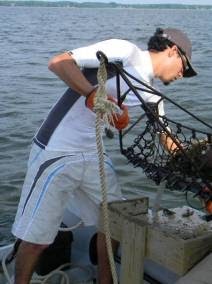
Jhoset Burgos Rodriguez (University of Puerto Rico)
Mentors: Dr. Salina Parveen, Meshak Mudoh
Research Project: The Effect of Storage Temperature on the Growth and Survival of Total and PathogenicVibrio parahaemolyticus in Chesapeake Bay Oysters
Vibrio parahaemolyticus (Vp) is a naturally occurring halophilic bacterium that can cause gastroenteritis in seafood consumers. Gastroenteritis in the US is usually associated with the ingestion of contaminated oysters. Information is limited on Vp growth and survival in oysters under various storage conditions. This study evaluated the effect of storage temperature on the growth and survival of total and pathogenic Vp in post-harvest shell-stock oysters. Oysters harvested from the Chesapeake Bay in the Summer of 2008 were stored at 5, 10, 15, 20, 25 and 30°C for selected time intervals. At each time interval, two replicates of six oysters each were analyzed for total Vp levels by direct plating/DNA probe for the species specific thermolabile hemolysin (tlh) gene. Pathogenic Vp levels were determined by MPN-qPCR analysis targeting the thermostable direct hemolysin (tdh) and thermostable-related hemolysin (trh) genes. The Baranyi D and linear models were fitted to the Vp growth and survival data to estimate the maximum growth rate (GR). GR estimates of total Vp at 5, 10, 15, 20, 25 and 30°C were -0.0007, -0.0018, 0.038, 0.058, 0.099 and 0.098 log CFU/h, respectively. Assuming a linear model for the initial growth phase, the best estimates of GR of tdh- and trh-positive Vp at 10, 15, 20, 25 and 30°C were 0.08, 0.14, 0.22, > 0.27, 0.17, and 0.048, 0.17, 0.26, and > 0.25, 0.27 log MPN/h, respectively. No growth of pathogenic Vp was detected at 5°C. The GR of pathogenic Vp was found to be substantially greater than those observed for total Vp. Pathogenic Vpmay multiply more rapidly than total Vp. The results of this study will assist risk managers and the seafood industry in designing more effective food safety systems.
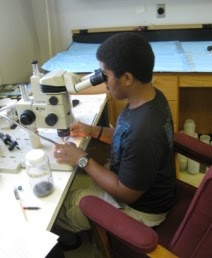
Kari Jackson (Morehouse College)
Mentors: Dr. Paulinus Chigbu, Ejiro Mayor
Research Project: Population Biology of Neomysis americana in the Maryland Coastal Bays
Although Neomysis americana serves as important prey for several commercially and recreationally important fish species in the Chesapeake and Maryland Coastal Bays (MCBs), little is known about its population biology. The objective of this study was to determine the abundance, distribution, size structure and fecundity ofN. americana in MCBs. Mysid samples were collected in May 2010 from four sites in the MCBs using an epibenthic sled towed behind a boat for 5 minutes. Mysids and other invertebrates collected were preserved in 10% buffered formalin. Temperature, salinity and D.O. were measured using YSI 85. In the lab, mysids were rinsed with water and transferred to 70% alcohol. Then, all the invertebrate animals caught were identified and counted. Total lengths of fifty (50) mysids selected randomly from samples collected at each site were measured using a ruler under a dissecting microscope. The number of eggs/embryos in the intact marsupium of selected females was also determined. Mysids (47%) and gammarid amphipods (48%) accounted for about 95% of the total number of macroinvertebrates caught, with grass shrimp (3.4%), crabs (0.33%) and other invertebrates (0.55%) accounting for the remaining percentage. There was a significant difference among sites in the mean size of mysids caught (ANOVA, df=3,196, F-test=3.365, p=0.02). Average size of the mysids varied from 6.49+0.18mm (site 12) to 7.66+0.42mm (site 16). The number of embryos in the brood pouch increased significantly with mysid size (r2=0.32, p=<0.05, n=26). These preliminary data will be used with additional data that will be collected in the future to provide detailed information on the biology and ecology of N. americana in the MCBs.
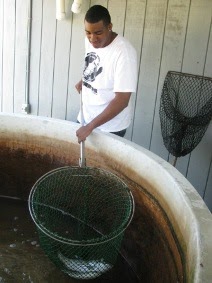
Adriel James (Morehouse College)
Mentor: Dr. Eric May, Lonnie Gonsalves
Research Project: Prevalence and Severity of Mycobacteriosis in White Perch (Morone Americana) of Varying Size
Juvenile white perch (Monrone americana) were collected from the Choptank River to determine whether there are size-related differences in the prevalence and severity of mycobacterial infection. Fish captured, ranging from small juveniles to young of year were sorted in groups according to their length (mm). The spleens, livers, hearts, and head kidneys were examined for presence or absence of granulomas using standard methods for paraffin embedded tissue and stained with hematoxylin and eosin (HE). Stained slides of the tissues were examined and the two main forms of granulomas, mycobacterial and parasitic, were recorded for each organ of each fish. Results suggest that the prevalence and severity of mycobacterial infection increased with fish length. Small white perch (40 – 100mm) were not normally infected by mycobacteriosis. Although juvenile fish did not show signs of mycobacteriosis, they showed signs of being parasitized and as fish length increased, the rate of parasitism also increased.
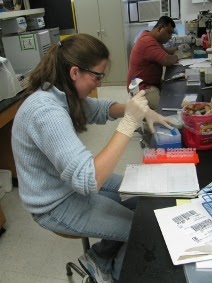
Linda Jordan (University of New England)
Mentors: Dr. Joseph Pitula, Whitney Dyson
Research Project: Testing for the presence of Hematodinium sp. and other dinoflagellates in the Maryland Coastal Bays using PCR analyses
The Maryland coastal bay watershed provides a habitat to a wide array of marine organisms. Our objective in this study was to test for various dinoflagellate communities in the Maryland coastal bays and to see if these communities contained a parasitic dinoflagellate called Hematodinium. We predicted that all our sample sites would show the presence of dinoflagellates, but, that only a few of the sites would produce a positive signal for Hematodinium. Water samples were collected in the Maryland coastal Bays from April to July 2010 and tested for the presence of Hematodinium sp. and other dinoflagellates with PCR analysis. We concluded that only five out of the six sites over a three month span had dinoflagellate DNA present in the water samples collected and no samples showed a positive signal for Hematodinium.
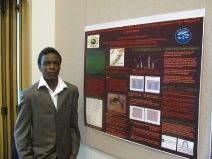
Rodrigue Lembvem (Case Western University)
Mentor: Dr. Paulinus Chigbu
Research Project: Some aspects of the population biology of blue crabs (Callinectes sapidus) in the Maryland Coastal Bays

James Lewis (University of Maryland University College)
Mentors: Dr. Andrea Johnson, Jamila Payton
Research Project: Effects of acute hypoxia on the Atlantic Croaker (Micropogonias undulatus) physiology
Hypoxia or low dissolved oxygen (DO < 2.5 mg/l) is present all around the globe including our Chesapeake Bay. The Atlantic croaker is a bottom dwelling fish found in the Chesapeake Bay. In this study, we collected Atlantic croaker (n = 32) by hook-and-line off Deal Island, Maryland. Atlantic croaker were acclimated in the laboratory for 7 days before being exposed to DO levels of 1.9 mg/L (hypoxic; n = 16) and 5.5 mg/L (normoxic; n = 16) for 24 hrs under laboratory conditions. We determined that there were no significant changes in Atlantic croaker blood indices with the exception of aspartate aminotransferase (AST). Spleno-somatic indices were significantly lower in hypoxic fish than normoxic. The behavior of the Atlantic croaker was different between hypoxic and normoxic treatments.

Chester McKenzie (University of Maryland Eastern Shore)
Mentor: Dr. Joseph Pitula, Whitney Dyson
Research Project: A PCR-based assay for detection of dinoflagellate communities and Hematodinium sp. in Sediment and Water from the Maryland Coastal Bays
Blue Crabs make up the most productive commercial and recreational fisheries in the Chesapeake Bay region. However, there has been a high prevalence of infections in the Blue crab by the Hematodinium sp. which is a parasitic dinoflagellate. Identifying free-living Hematodinium sp. from environmental samples will be the key in understanding how the Hematodinium sp. infects the Blue Crab, and the life stages in which the Hematodinium sp. and Blue crab are in when infection occurs. Discovering and finding dinoflagellate communities in the environment will also be a critical task in order to determine if Hematodinium sp. is dependent on other dinoflagellate communities to live. In order to carry out this investigation, the National Park Service (NPS), Institute of Marine and Environmental Technology (IMET) and University of Maryland Eastern Shore (UMES) collected environmental samples from specific areas along the Maryland Coastal Bays. Samples were collected for four months (April – July), and Polymerase Chain Reaction (PCR) – based techniques were carried out with the environmental samples collected from those four months in order to detected free-living presence of the Hematodinium sp. parasite.

Amy Parekh (Temple University)
Mentors: Dr. Andrea Johnson, Dr. Eric May, Lonnie Gonsalves,
Research Project: Temporal Difference in Prevalence and Severity of Mycobacterial Granulomas and Macrophage Aggregates in Striped Bass (Morone saxatilis) using Histological Methods
Striped bass (Morone saxatilis) are an important component of the Chesapeake Bay. Chesapeake Bay striped bass are currently undergoing a chronic epizootic ofMycobacterium spp. In addition, these fish potentially experience several physiological stressors including hypoxia and nutritional deficiencies that may become more prevalent during the summer. This study will explore whether there are differences in mycobacteriosis severity and physiological stress in summer- and fall-collected striped bass via histological examination of the spleen. Seventy-nine striped bass were caught in the summer and the late fall of 2009 from the Choptank River. Histological sections of the spleen were examined to determine if the percent coverage and number of granulomas as well as the concentration of macrophage aggregates varies temporally. Striped bass had significantly more granulomas in the summer than in the fall and significantly higher concentrations of macrophage aggregates in the fall than in the summer.


